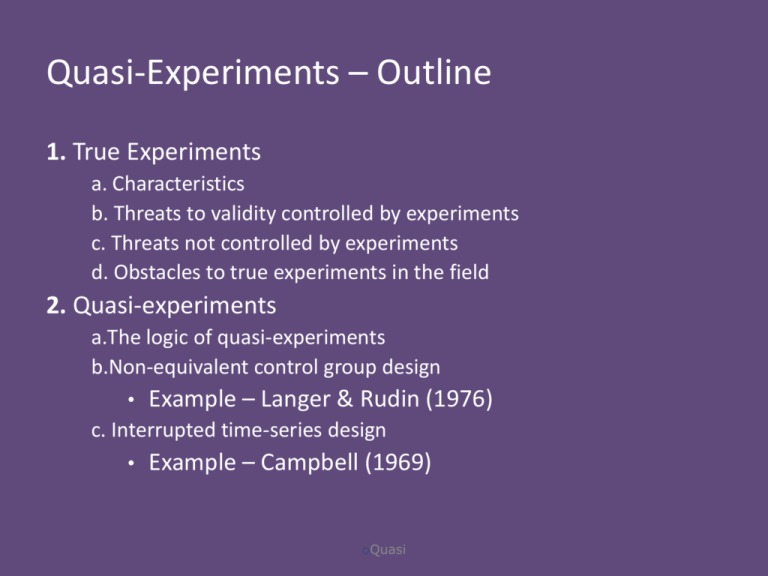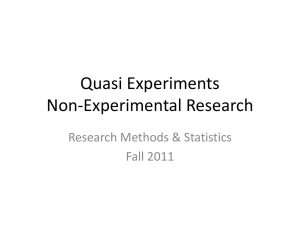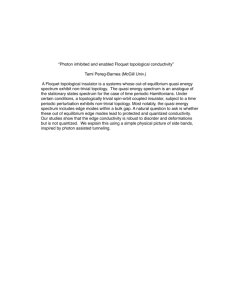Quasi-experiments
advertisement

Quasi-Experiments – Outline 1. True Experiments a. Characteristics b. Threats to validity controlled by experiments c. Threats not controlled by experiments d. Obstacles to true experiments in the field 2. Quasi-experiments a.The logic of quasi-experiments b.Non-equivalent control group design • Example – Langer & Rudin (1976) c. Interrupted time-series design • Example – Campbell (1969) Quasi True Experiments - Characteristics • True experiments are characterized by: • A manipulation • A high degree of control • An appropriate comparison (the major goal of exerting control) • Manipulation in the presence of control gives you an appropriate comparison. Quasi Threats to validity controlled by true experiments • History • occurrence of an event other than the treatment Quasi Threats to validity controlled by true experiments • Maturation • participants always change as a function of time. Is change in behavior due to something else? Quasi Threats to validity controlled by true experiments • Testing • improvement due to practice on a test (familiarity with procedure, or with testers expectations) Quasi Threats to validity controlled by true experiments • Instrumentation • especially if humans are used to assess behavior (fatigue, practice) Quasi Threats to validity controlled by true experiments • Regression • when first observation is extreme, next one is likely to be closer to the mean. Quasi Threats to validity controlled by true experiments • Selection • if differences between groups exist from the outset of a study Quasi Threats to validity controlled by true experiments • Mortality • if exit from a study is not random, groups may end up very different Quasi Threats to validity controlled by true experiments • Interactions of selection… • with History • with Maturation • with Instrumentation (ceiling effects) Quasi Note difference between these threats: • Maturation • One group; performance better on post-test than on pre-test • Interaction of Maturation & Selection • Two or more groups • Performance difference larger on post-test than on pre-test Quasi Threats to validity not controlled by experiments • Contamination • Cook & Campbell (1979): • communication of information about the experiment between groups of subjects Quasi • resentment • ‘compensatory rivalry’ • diffusion of treatment: control subjects use information given to others to change their own behavior. Contamination – an example • Craven, Marsh, Debus, & Jayasinghe (2001) • Journal of Educational Psychology • Teachers trained to improve students’ academic self-concept through praise • Internal control • External control Quasi Contamination – an example • Craven, Marsh, Debus, & Jayasinghe (2001) • Next slide shows T2 (posttest) academic selfconcept scores as a function of T1 scores for control children only. Quasi T2 acad self concept 1.0 0.5 No diffusion Resentful demoralization? Overzealous cooperation? 0.0 Low focus group consistently higher than external control -0.5 Diffusion -1.0 Low Medium External control Internal control High T1 acad self concept Internal high focus Internal low focus Threats to validity not controlled by experiments • Threats to external validity • best way to deal with this is replication Quasi Threats to validity not controlled by experiments • Hawthorne effects • changes in a person’s behavior due to being studied rather than the manipulation. • a special kind of reactivity. Quasi Hawthorne effects • Demand characteristics • cues communicated by researcher • subject’s under-standing of their role Quasi Hawthorne effects • Role of “research subject” • Is subject behaving the way he thinks a person in that role should behave? • (E.g., hypnotized person) Quasi Hawthorne effects • Orne (1962) • ‘good subjects’ think they are contributing to science by complying with researcher’s demands Quasi Hawthorne effects • What to do about Hawthorne effects? • Orne (1962): Use quasicontrol subjects as “coinvestigators” • They do your task, reflect on demand characteristics of the experiment. Quasi Obstacles to true experiments in the field • Sometimes, we cannot bring the phenomenon we want to study into the lab, so we have to work in the field. • Can we do experiments in the field? Quasi Obstacles to true experiments in the field • Can’t get permission from individuals in authority? • Your study may involve some time and effort on their part. But what’s in it for them? • In schools, parents also have to agree. Quasi Obstacles to true experiments in the field • Can’t assign subjects to groups randomly? • have to work with intact groups (e.g., classes in a school) Quasi Quasi-Experiments • Quasi-experiments resemble true experiments… • …but they are not true experiments. • lack high degree of control that is characteristic of true experiments. • usually include a manipulation, and provide a comparison. Quasi Quasi-Experiments • Quasi-Experiments are compromises • They allow the researcher some control when full control is not possible. Quasi Quasi-Experiments • Because full control is not possible, there may be several “rival hypotheses” competing as accounts of any change in behavior observed. • How do we convince others that our hypothesis is the right one? Quasi The Logic of Quasi-Experiments • Eliminate any threats you can • Show how each threat to validity on list given above is dealt with in your study. • Argue that others don’t apply. • using evidence or logic Quasi Two kinds of quasi-experiments • Non-equivalent control group • Quasi “non-equivalent” because not randomly assigned Two kinds of quasi-experiments • Interrupted time-series design • Quasi a series of observations over time, interrupted by some treatment Non-equivalent Control Group design • Control group is “like” the treatment group. • Chosen from same population • Pre- and post-test measures obtained for both groups, so similarity can be assessed. Quasi Non-equivalent Control Group design • Control group is not equivalent • subjects are not randomlyassigned to control & treatment groups • so best you can do is argue that comparison is appropriate. Quasi Non-equivalent Control Group design • If the groups are comparable to begin with, this design potentially eliminates threats to internal validity due to: • • • • • Quasi History Maturation Testing Instrumentation Regression Problems with the NECG design • Threats to validity due to interactions with selection may not be eliminated using the NECG design. • Selection and maturation • Most likely when treatment group is self-selected (as in psychotherapy cases – people who sought help). Quasi Problems with the NECG design • Selection and history • Does one group experience some event that has a positive or negative effect (e.g., teacher of one class leaves)? Quasi Problems with the NECG design • Selection and instrumentation • Does one group show ceiling or floor effects? Quasi Problems with the NECG design • Regression to the mean • Are one group’s pretest scores more extreme than the other group’s? Quasi Possible NECG study outcomes • both experimental and control groups show improve-ment from pretest to posttest • appears not to be any effect of the treatment Pretest Posttest Control group Quasi Possible NECG study outcomes • Looks like a treatment effect, but there may be a threat due to • selection and maturation, • selection and history Pretest Posttest Control group Quasi Possible NECG study outcomes • Selection and maturation could be a threat • Or interaction of selection and • • • • history testing instrumentation or mortality. Pretest Posttest Control group Quasi Possible NECG study outcomes • Interaction of selection and regression looks like a serious threat here • Selection and maturation probably not a threat here. Pretest Quasi Posttest Possible NECG study outcomes • Crossover effect • Clearest evidence for an effect of the program of any of these graphs. • Selection and instrumentation not a problem – no ceiling or floor effects Pretest Quasi Posttest Quasi-experiment example • Langer & Rudin (1976) • Research conducted in retirement home. • Residents on one floor given more control over their daily lives • Residents of another floor given same interaction with staff, but no increased control. Quasi Langer & Rudin (1976) – Measures • Ratings • Objective measures • Self-report of feeling of control from residents • Staff assessments of mental & physical well-being, by ‘blind’ assessors Quasi • record of movie attendance • participation in “Guess how many jelly-beans” contest on each floor L & R (1976) – limits on control • L & R had no control over • who entered the home • who was assigned to either floor. • no control over staff hiring or firing / resigning. Quasi L & R (1976) – Possible Problems • Interaction of Selection and Maturation • even if groups have similar pretest scores, they may differ on things pretest didn’t measure • probably not a problem here – people on both floors had similar SES • assigned to floors randomly, not by health status. Quasi L & R (1976) – Possible Problems • Selection and history • suppose a popular (or unpopular) nurse left one of the floors during the study. That might influence wellbeing. • L & R did not address this issue. Quasi L & R (1976) – Possible Problems • Selection and instrumentation • did one group show ceiling or floor effects? • L & R say, no. Quasi L & R (1976) – Possible Problems • Regression • were one group’s pretest scores more extreme than the others? • L & R say, no. Quasi L & R (1976) – Possible Problems • Observer bias and Contamination • observers in the L & R study were not aware of the hypothesis. • L & R reported there was little communication between floors. Quasi L & R (1976) – Possible Problems • Hawthorne Effect • cannot be ruled out, but L & R took care to give both floors same attention. • Message varied between floors, but “face time” was the same. Quasi L & R (1976) – Possible Problems • External Validity • might be an issue. • home involved was rated “one of the finest” in the state • subjects may have been atypical in their desire for control Quasi Two kinds of quasi-experiments Non-equivalent control group • Interrupted time-series design • • Quasi a series of observations over time, interrupted by some treatment Time-Series Designs • In T-S designs, performance is measured both before and after a treatment. • If there is an abrupt change in performance at time of treatment, we conclude that treatment worked. Quasi Time-series designs example • Campbell (1969) • Effect of speed limit reduction on traffic fatalities in Connecticut • incidence of traffic fatalities in years before and after the speed limit reduction, • conclusion: speed limit change had a modest effect. Quasi Campbell (1969) • Any threat to internal validity? • other explanations for any change in traffic fatality incidence: • Changes in car safety • Weather • Record keeping Quasi Campbell (1969) • Any threat to internal validity? • Such effects should be similar in neighboring states • Campbell found no change in fatality incidence in those states. Quasi Campbell (1969) • Any threat to external validity? • E.g., would treatment have same effect in other states, or are people in Connecticut more lawabiding? Quasi Campbell (1969) • Time-series design eliminates most other threats to validity – e.g., maturation, testing, regression. • For example, maturation would probably not produce a sudden change in performance of the kind found in Time-Series Designs. Quasi





